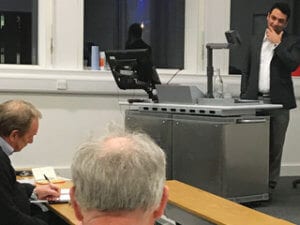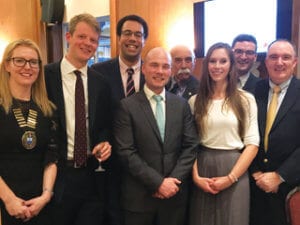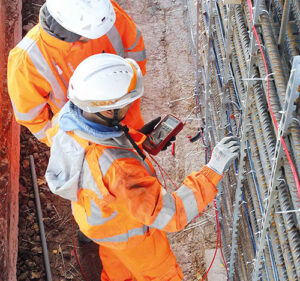The second presentation of the 17/18 season was a joint meeting with TWI, and James Hesketh of the National Physical Laboratory gave a presentation on the Influence of H2S on the Pit to Crack Transition in Sour Testing of Corrosion Resistant Alloys.

James Hesketh received a vote of thanks from Stephen Shapcott of TWI on an excellent presentation and received gifts from both TWI and ICorr.
James highlighted that stable pitting is a precursor to sulphide stress corrosion cracking (SSCC), which is one of the main causes of failure of stainless steel pipelines used in sour Oil and Gas production. Despite this, the underlying mechanism governing the growth of such pits is poorly understood, and hence materials selection for sour service is dependent upon costly and time consuming environmental exposure and SSCC test programmes.
In the study at NPL, the role of hydrogen sulphide (H2S) in pit propagation was investigated as a first step towards the development of accelerated test methods for SSCC resistance. Novel electrochemical techniques were employed to determine the relationship between bulk solution chemistry and the critical pit chemistry required to induce stable pitting in sour environments. James stressed that electrochemical measurements are correlated with results obtained from standard SSCC tests and are rationalised in terms of the balance between H2S diffusion through the pit mouth, H2S consumption within the pit and the role of the external cathode.
He also explained that there was a systematic decrease in pit size with increasing H2S concentration. Also that a greater peak current was measured at higher H2S concentrations and repassivation was slower.
The 29th London Branch Lunch, held at The Royal Overseas League in early December, was another huge success with 177 people attending the event in Mayfair London.
Guests started to arrive at 11.30 for a pre-lunch drink and were seated by 12.30 for the first of two acts by The Sirens a group of three singing performers, which was really well received and set the scene for the afternoon. The meal was yet again excellent and congratulations to the ROSL who never disappoint. After the lunch the Chair of London Branch thanked the luncheon organising committee ad the branch committee, who continue to drive the Institute in London forward.
The President then addressed the guests to a rapturous applause once again thanking everyone for their support and explaining that the Institute has exciting plans that will start in Q1 2018.

From left – right, Sarah Vasey, Chris Bridge Simon Bowcock, Trevor Osborne, Charlotte Vie, David Mobbs and Bill Hedges.
After the raffle, two guests were honoured with a small gift in recognition of them receiving the Tallow Chandlers Award for their work in materials and corrosion, a tremendous achievement by Charlotte Vie in 2016 and Simon Bowcock in 2017.
The timing for the event this year was slightly different allowing guests to socialise and network at the ROSL until 7.00pm which appeared to be extremely popular with lots of notes being taken and exchanging of business cards.
Thanks go again to all those that assisted in the organisation of the event and we look forward to another exciting event in December 2018. Hamed Habibi, Technical Director of Speir Hunter Ltd, gave an interesting presentation entitled “Developments in Remote Magnetic Monitoring of stress in ferromagnetic Pipeline” at the January meeting.
The talk introduced and explained the benefits of stress monitoring in pipeline integrity management. It is the only inspection technique that can simultaneously map the lateral position and depth of cover of a pipeline whilst providing comprehensive defect detection. Several case studies were discussed to illustrate the advantages of this the technique, also known as Stress Concentration Tomography, over traditional inspection methods. The technique is able to assess condition of buried pipelines remotely and is not dependent on the type of defect, size of pipe, construction configuration or operating condition, and can save a considerable amount of time, effort and budget while providing an accurate 3 dimensional mapping of a pipe and surrounding objects. The technique can also identify location of casings and wrinkle bends, information becoming required by the regulatory authorities.




